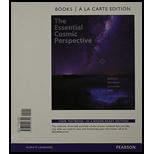
Essential Cosmic Perspective, The, Books a la Carte Edition & Modified MasteringAstronomy with Pearson eText -- ValuePack Access Card -- for The Essential Cosmic Perspective Package
1st Edition
ISBN: 9780133879216
Author: Jeffrey O. Bennett, Megan O. Donahue, Nicholas Schneider, Mark Voit
Publisher: PEARSON
expand_more
expand_more
format_list_bulleted
Question
Chapter 6, Problem 12EAP
To determine
What was the heavy bombardment and when did it occur.
Expert Solution & Answer
Want to see the full answer?
Check out a sample textbook solution
Students have asked these similar questions
A capacitor with a capacitance of C = 5.95×10−5 F is charged by connecting it to a 12.5 −V battery. The capacitor is then disconnected from the battery and connected across an inductor with an inductance of L = 1.55 H . At the time 2.35×10−2 s after the connection to the inductor is made, what is the current in the inductor? At that time, how much electrical energy is stored in the inductor?
Can someone help me with this question. Thanks.
Can someone help me with this question. Thanks.
Chapter 6 Solutions
Essential Cosmic Perspective, The, Books a la Carte Edition & Modified MasteringAstronomy with Pearson eText -- ValuePack Access Card -- for The Essential Cosmic Perspective Package
Ch. 6 - Prob. 1VSCCh. 6 - Prob. 2VSCCh. 6 - Prob. 3VSCCh. 6 - Prob. 1EAPCh. 6 - Prob. 2EAPCh. 6 - Prob. 3EAPCh. 6 - What are the basic differences between terrestrial...Ch. 6 - Prob. 5EAPCh. 6 - Prob. 6EAPCh. 6 - Prob. 7EAP
Ch. 6 - Describe the four categories of materials in the...Ch. 6 - Prob. 9EAPCh. 6 - Prob. 10EAPCh. 6 - Prob. 11EAPCh. 6 - Prob. 12EAPCh. 6 - What is the leading hypothesis for the Moon’s...Ch. 6 - Prob. 14EAPCh. 6 - Prob. 15EAPCh. 6 - Prob. 16EAPCh. 6 - Prob. 17EAPCh. 6 - Prob. 18EAPCh. 6 - Prob. 19EAPCh. 6 - Prob. 20EAPCh. 6 - Prob. 21EAPCh. 6 - Prob. 22EAPCh. 6 - Prob. 23EAPCh. 6 - Prob. 24EAPCh. 6 - Prob. 25EAPCh. 6 - Prob. 26EAPCh. 6 - Prob. 27EAPCh. 6 - Which of the following did not occur during the...Ch. 6 - Prob. 29EAPCh. 6 - Prob. 30EAPCh. 6 - Leftover ice-rich planetesimals are called (a)...Ch. 6 - Prob. 32EAPCh. 6 - Prob. 33EAPCh. 6 - Prob. 34EAPCh. 6 - Prob. 35EAPCh. 6 - Unanswered Questions. As discussed in this...Ch. 6 - A Cold Solar Nebula. Roles: Scribe (takes notes on...Ch. 6 - True or False. Decide whether each statement is...Ch. 6 - Planetary Tour. Based on the brief planetary tour...Ch. 6 - Patterns of Motion. In one or two paragraphs,...Ch. 6 - Solar System Trends. Study the planetary data in...Ch. 6 - 42. Two Kinds of Planets. The jovian planets...Ch. 6 - An Early Solar Wind. Suppose the solar wind had...Ch. 6 - History of the Elements. Our bodies (arid most...Ch. 6 - Rocks from Other Solar Systems. Many leftovers’...Ch. 6 - Radiometric Dating. You are dating rocks by their...Ch. 6 - Lunar Rocks. You are dating Moon rocks based on...Ch. 6 - Carbon-14 Dating. The half-life of carbori-14 s...Ch. 6 - Prob. 49EAPCh. 6 - Prob. 50EAPCh. 6 - Lucky to Be Here? Considering the overall process...Ch. 6 - Prob. 52EAPCh. 6 - Prob. 53EAP
Knowledge Booster
Learn more about
Need a deep-dive on the concept behind this application? Look no further. Learn more about this topic, physics and related others by exploring similar questions and additional content below.Similar questions
- Can someone help me with this question. Thanks.arrow_forwardIdentical rays of light enter three transparent blocks composed of different materials. Light slows down upon entering the blocks.arrow_forwardFor single-slit diffraction, calculate the first three values of (the total phase difference between rays from each edge of the slit) that produce subsidiary maxima by a) using the phasor model, b) setting dr = 0, where I is given by, I = Io (sin (10) ². 2arrow_forward
arrow_back_ios
SEE MORE QUESTIONS
arrow_forward_ios
Recommended textbooks for you
 College PhysicsPhysicsISBN:9781305952300Author:Raymond A. Serway, Chris VuillePublisher:Cengage Learning
College PhysicsPhysicsISBN:9781305952300Author:Raymond A. Serway, Chris VuillePublisher:Cengage Learning University Physics (14th Edition)PhysicsISBN:9780133969290Author:Hugh D. Young, Roger A. FreedmanPublisher:PEARSON
University Physics (14th Edition)PhysicsISBN:9780133969290Author:Hugh D. Young, Roger A. FreedmanPublisher:PEARSON Introduction To Quantum MechanicsPhysicsISBN:9781107189638Author:Griffiths, David J., Schroeter, Darrell F.Publisher:Cambridge University Press
Introduction To Quantum MechanicsPhysicsISBN:9781107189638Author:Griffiths, David J., Schroeter, Darrell F.Publisher:Cambridge University Press Physics for Scientists and EngineersPhysicsISBN:9781337553278Author:Raymond A. Serway, John W. JewettPublisher:Cengage Learning
Physics for Scientists and EngineersPhysicsISBN:9781337553278Author:Raymond A. Serway, John W. JewettPublisher:Cengage Learning Lecture- Tutorials for Introductory AstronomyPhysicsISBN:9780321820464Author:Edward E. Prather, Tim P. Slater, Jeff P. Adams, Gina BrissendenPublisher:Addison-Wesley
Lecture- Tutorials for Introductory AstronomyPhysicsISBN:9780321820464Author:Edward E. Prather, Tim P. Slater, Jeff P. Adams, Gina BrissendenPublisher:Addison-Wesley College Physics: A Strategic Approach (4th Editio...PhysicsISBN:9780134609034Author:Randall D. Knight (Professor Emeritus), Brian Jones, Stuart FieldPublisher:PEARSON
College Physics: A Strategic Approach (4th Editio...PhysicsISBN:9780134609034Author:Randall D. Knight (Professor Emeritus), Brian Jones, Stuart FieldPublisher:PEARSON

College Physics
Physics
ISBN:9781305952300
Author:Raymond A. Serway, Chris Vuille
Publisher:Cengage Learning

University Physics (14th Edition)
Physics
ISBN:9780133969290
Author:Hugh D. Young, Roger A. Freedman
Publisher:PEARSON

Introduction To Quantum Mechanics
Physics
ISBN:9781107189638
Author:Griffiths, David J., Schroeter, Darrell F.
Publisher:Cambridge University Press

Physics for Scientists and Engineers
Physics
ISBN:9781337553278
Author:Raymond A. Serway, John W. Jewett
Publisher:Cengage Learning

Lecture- Tutorials for Introductory Astronomy
Physics
ISBN:9780321820464
Author:Edward E. Prather, Tim P. Slater, Jeff P. Adams, Gina Brissenden
Publisher:Addison-Wesley

College Physics: A Strategic Approach (4th Editio...
Physics
ISBN:9780134609034
Author:Randall D. Knight (Professor Emeritus), Brian Jones, Stuart Field
Publisher:PEARSON
Kepler's Three Laws Explained; Author: PhysicsHigh;https://www.youtube.com/watch?v=kyR6EO_RMKE;License: Standard YouTube License, CC-BY